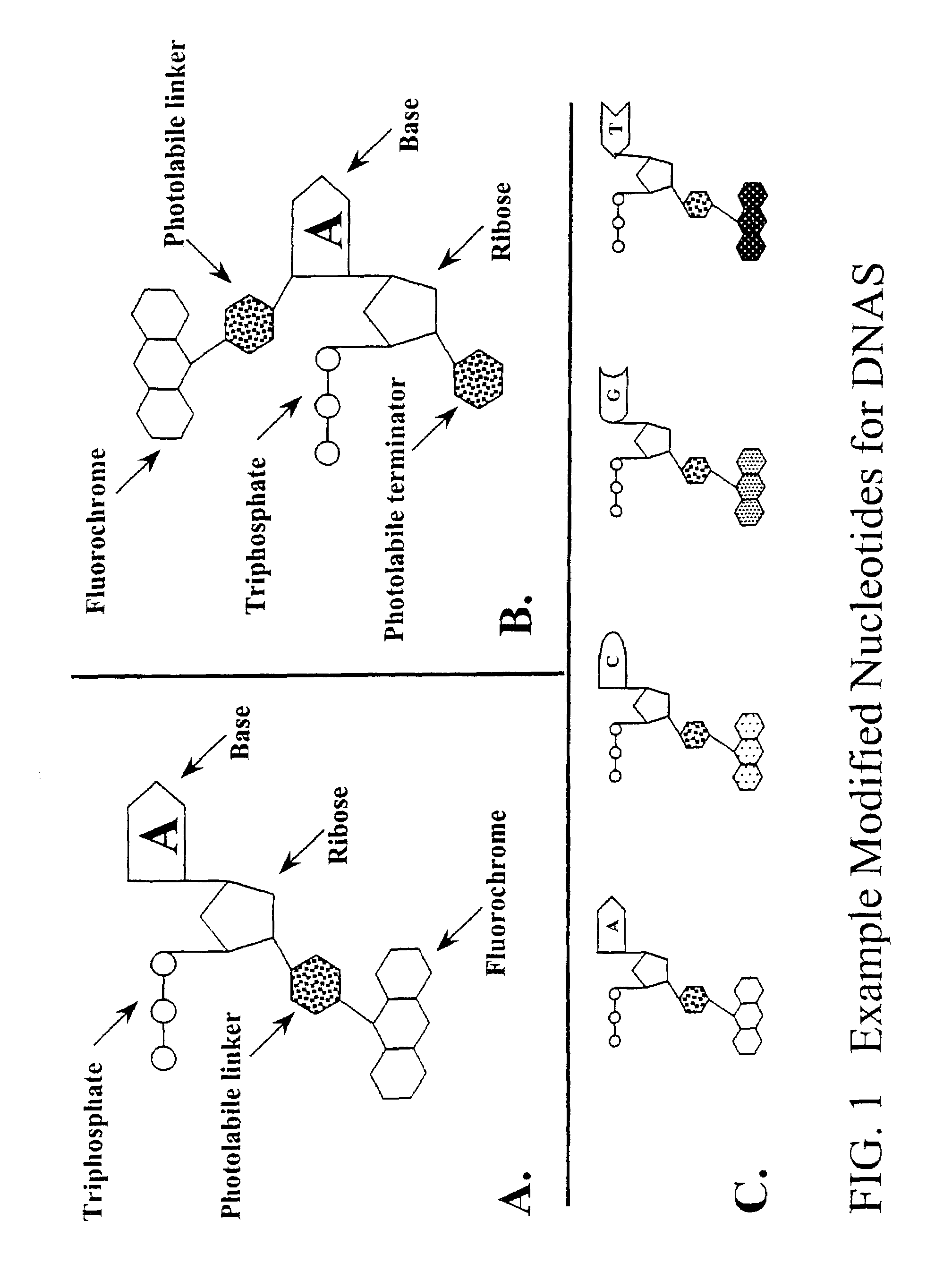Method for direct nucleic acid sequencing
a nucleic acid and sequencing technology, applied in nanoinformatics, instruments, organic chemistry, etc., can solve the problems of release or incorporation, failure of reaction centers, etc., and achieve the effects of eliminating the need for amplification, high throughput, and high throughpu
- Summary
- Abstract
- Description
- Claims
- Application Information
AI Technical Summary
Benefits of technology
Problems solved by technology
Method used
Image
Examples
example 1
Reaction Chamber Substratum Preparation, Nickel / chelator Conjugate
[0121]The fundamental unit of the DNAS methodology is the reaction center (FIG. 3). The reaction center comprises a polymerase molecule bound to a template nucleic acid molecule, and tethered to a fixed location on a transparent substrate via a high affinity interaction between groups attached to the polymerase and substrate respectively. In one configuration, DNAS reactions occur in a reaction chamber whose base, the substrate, is made of glass (SiO2) modified so that polymerase molecules can be attached in a regular array. Using electron beam lithography a square array of dimensions 100 μm×100 μm is generated. Rai-Choudhury, Handbook of Microlithography, Micromachining, and Microfabrication, Volume I; Microlithography, Volume PM39, SPIE Press (1997). A small spot, Anal Chem 69: 1979-1985 (1997). Each nitrilotriacetic acid group serves as a chelator for a Ni2− ion. The coordinated Ni2− ion can then be bound by hexahi...
example 2
Microfluidic Reaction Chamber Allows Rapid Exchange of Reactants Buffer and Products
[0122]The reaction chamber is a device that houses the array of reaction centers and regulates the environment. As described in Example 1, the substrate is a glass microscope slide prepared with a regular microscopic array of covalently moieties. A prism is attached to the slide on the surface opposite to the array. The prism directs laser light into the slide at such an angle that total-internal reflection of the laser light is achieved within the slide. Under this condition an evanescent wave is generated over the array during the sequencing reaction cycle. The slide and prism are fixed into an assembly, which will generate a sealed chamber with a volume of 1-10 μl (FIG. 4) Reagents and buffer are pumped into and outof the chamber through microfluidic ports on either side of the chamber. Complete exchanges of volume take place within 1 second and are mediated by electronically controlled valves and...
example 3
Preparation of Labeled-Caged Chain Terminating Nucleotides
Preparation of Fluorochrome-Photolabile Linker Conjugate
[0123]Fluorochrome-liriked 2-nitrobenzyl derivatives are first generated as described by Anasawa, et al., WO 98 / 33939. Alternatively a sensitized photolabile linker (e.g., using DMNPE caging kit, Catalog Number D-2516, Molecular Probes, Inc.) may be first attached to the 3′ group of the dNTP as detailed below and then linked to a fluorochrome using succinimide chemistry or otherwise. It may prove optimal to use a linker of variable length between the fluorochrome and the caging group to reduce possible steric hindrance caused by large chemical groups. Brandis, et al., Biochemistry 35: 2189-2200 (1996).
Preparation of 3′-O-modified-2′-deoxynucleotide analogs
[0124]3′-O-modified-2′-deoxynucleotides are synthesized by esterification of the 3′-OH group of dATP, dCTP, dGTP and dTTP. This is accomplished by several general methods. Metzker, et al., Nucleic Acids Res 22: 4259-426...
PUM
| Property | Measurement | Unit |
|---|---|---|
| temperature | aaaaa | aaaaa |
| uncaging wavelength | aaaaa | aaaaa |
| wavelength | aaaaa | aaaaa |
Abstract
Description
Claims
Application Information
 Login to View More
Login to View More - R&D
- Intellectual Property
- Life Sciences
- Materials
- Tech Scout
- Unparalleled Data Quality
- Higher Quality Content
- 60% Fewer Hallucinations
Browse by: Latest US Patents, China's latest patents, Technical Efficacy Thesaurus, Application Domain, Technology Topic, Popular Technical Reports.
© 2025 PatSnap. All rights reserved.Legal|Privacy policy|Modern Slavery Act Transparency Statement|Sitemap|About US| Contact US: help@patsnap.com



